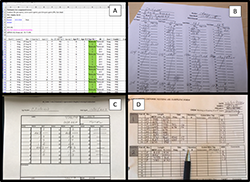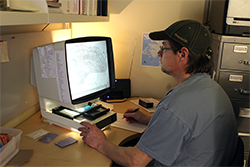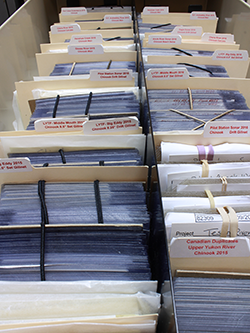Data Recording and Entry

B Photo: Larry Dubois, 2017.
C Photo: Carla Milburn, 2017.
D Photo: Jeff Perschbacher, 2016.
Last modified on Mar 20, 2019
Age data recording is typically a two step process: an initial hand-writing or keying of the age estimation while reading scales, and transcription of age data into a database.
Microfiche viewer
Scale patterns are viewed by positioning the acetate on the tray of a microfiche viewer. The microfiche viewer functions by shining a light through the acetate, which is then magnified through a lens, reflected off a mirror, and the shadow is viewed on a screen. Different microfiche viewers used in Alaska are the Micron 780, Eyecom 3000, and Indus Screen Scan. The lens sizes used range from 15 mm to 22 mm that magnify the scale 36x to 48x.
Age datasheet
While reading scales, age data is recorded on an age datasheet. In Alaska, most datasheets are paper, even where sex and length are collected electronically in the field. Some age datasheets are Excel files (Figure 2).
Age datasheets have space for multiple cards on one page. For each card, there are labels for fish number and spaces for the age estimate, error code, and comment. The top of each datasheet should have the same information on the gummed card and acetate (species, location, district, sub-district, project, gear) as well as reader name and date read.
Ages are recorded in European notation. In other words, the number preceding the decimal refers to the number of freshwater annuli and number following the decimal refers to the number of marine annuli (Koo 1962). When an age can not be estimated, an error code is recorded instead of an age. These codes include (see glossary for explanation):
| Code | Description |
|---|---|
| 2 | Inverted |
| 3 | Regenerated |
| 4 | Illegible |
| 5 | Missing |
| 6 | Resorbed |
| 7 | Wrong species |
| 8 | Not preferred |
| 9 | No freshwater age |
| 10 | No saltwater age |
Comments, questions, and other codes, such as edge codes, useful for understanding an age estimate are often recorded as well.
Database and data storage
Age data, along with biological and sampling data, are entered in a standardized format to a database. Standardized formats range from Excel files to bubble sheets.
To be useful, data need to be understandable and accessible. Thus, getting Age-Sex-Length (ASL) and associated data into a secure, reliable, and accessible repository with standardized formats is as important as sample collection and age estimation. Historically, some variations of formats, coding, and definitions have been used across Alaska's commercial fisheries regions. The Alaska Salmon Biological Data Repository-v2.3 (PDF 412 kB) (AK-SBDR) was made to standardize terminology and data practices. As of 2019, some regional offices are still working to bring data up to the AK-SBDR standards.
Regardless of what standards are used, it is important that the data, sampling methods, and analyses are well- documented. Such documentation is called metadata, or data describing data. Biologists who follow after ASL sampling occur will need to know: precisely where samples were collected (location and latitude-longitude), when samples were collected (date and time), what units were used for measurements (cm, kg, mL, etc.), what methods were used for age estimation, and other details associated with the data. Properly documented metadata makes analyses easier to conduct and less error prone.
References
Koo, T. 1962. Age designation in salmon. Studies of Alaska red salmon. University of Washington Publications in Fisheries, New Series vol. 1: 37-48.
Product names used in this publication are included for completeness and do not constitute product recommendation or endorsement.


